Nail polish
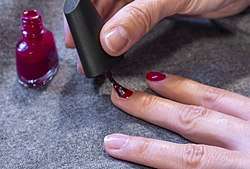
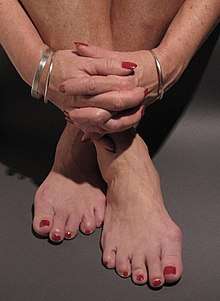
Nail polish (also known as nail varnish) is a lacquer that can be applied to the human fingernail or toenails to decorate and protect the nail plates. The formulation has been revised repeatedly to enhance its decorative effects, and to suppress cracking or flaking. Nail polish consists of a mix of an organic polymer and several other components, depending on the brand.[1] People use this liquid to create both simple and complicated designs with bright colors, charms, or other.
History
Nail polish originated in China and dates back to 3000 BC.[1][2] Around 600 BC, during the Zhou dynasty, the royal house preferred the colors gold and silver.[1] However, red and black eventually replaced these metallic colors as royal favorites.[1] During the Ming dynasty, nail polish was often made from a mixture that included beeswax, egg whites, gelatin, vegetable dyes, and gum arabic.[1][2]
In Egypt, the lower classes wore pale colors, whereas high society painted their nails a reddish brown color, with henna.[3][4] Mummified pharaohs also had their nails painted with henna.[5]
Colored nail polish did not make an appearance until the 1920s. Early nail polish formulas were created using basic ingredients such as lavender oil, Carmine, oxide tin, and bergamot oil.[6] It was more common to polish nails with tinted powders and creams, and finish by buffing the nail until left shiny. One type of polishing product sold around this time was Graf's Hyglo nail polish paste.[6]
Ingredients

- Nail polish consists of a film-forming polymer dissolved in a volatile organic solvent. Nitrocellulose that is dissolved in butyl acetate or ethyl acetate is common. This basic formulation is expanded to include the following:[7]
- Plasticizers to yield non-brittle films. Dibutylphthalate and camphor are typical plasticizers.
- Dyes and pigments. Representative compounds include chromium oxide greens, chromium hydroxide, ferric ferrocyanide, stannic oxide, titanium dioxide, iron oxide, carmine, ultramarine, and manganese violet.[8]
- Opalescent pigments. The glittery/shimmer look in the color can be conferred by mica, bismuth oxychloride, natural pearls, and aluminum powder.
- Adhesive polymers ensure that the nitrocellulose adheres to the nail's surface. One modifier used is tosylamide-formaldehyde resin.[9]
- Thickening agents are added to maintain the sparkling particles in suspension while in the bottle. A typical thickener is stearalkonium hectorite. Thickening agents exhibit thixotropy, their solutions are viscous when still but free flowing when agitated. This duality is convenient for easily applying the freshly shaken mixture to give a film that quickly rigidifies.[10]
- Ultraviolet stabilizers resist color changes when the dry film is exposed to sunlight. A typical stabilizer is benzophenone-1.
Types
Base coat
This type of nail polish is a clear, milky-colored, or opaque pink polish formula that is used specifically before applying nail polish to the nail.[11] The purpose of it is to strengthen nails, restore moisture to the nail, and/or help polish adhere to the nail so staining will not occur and the manicure lasts longer than without a base coat.[12] Some base coats are marketed as "ridge fillers" which can create a smooth surface, and reduce the appearance of the ridges that can appear on unbuffed nails. Some base coats called "peel off base coats" allow the user to peel off their nail polish without using a remover.
Top coat
This type of nail polish is a clear colored polish formula that is used specifically after applying nail polish to the nail. It forms a hardened barrier for the nail that can prevent chipping, scratching and peeling. Many top coats are marketed as "quick-drying." Top coats can help the underlying colored polish dry quickly as well. It gives the polish a more finished and desired look and may help to keep the polish on for longer.[12]
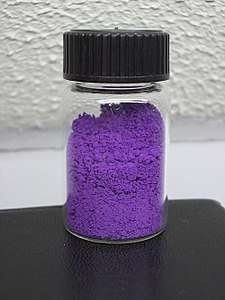
Gel
Gel polish is a long-lasting variety of nail polish made up of a type of methacrylate polymer. It is painted on the nail similar to traditional nail polish, but does not dry. Instead it is cured under an ultraviolet lamp or ultraviolet LED. While regular nail polish formulas typically last two to seven days without chipping, gel polish can last as long as two weeks with proper application and home care. Gel polish can be more difficult to remove than regular nail polish. It is usually gently pushed off (often with a wooden stick) after soaking the nails in pure acetone (the solvent used in most nail polish removers) for eight to fifteen minutes.
Matte
Matte polish is like regular polish, but has a purposely dull finish rather than a shine. It can be purchased as a regular base coat in ranges of different colors. Matte nail polish can also be found in a top coat. Matte top coat is most useful for painting over any dry base color, giving it a different appearance. The matte top coat polish will dull the shine from a regular base coat polish. Matte polish has become very popular through the years, particularly since it can be used in nail art applications, where designs can be created on the nail using the contrast of both shiny and matte surfaces.
Shellac
Shellac nail polish is a long-lasting polish that can go on acrylic, artificial nails or the natural nail that gives off a fresh shiny look. This type of polish can last up to 4 weeks with minimal chipping and is healthier for the natural nail compared to an acrylic nail which leaves the natural nail thin and flakey. Shellac is also used as a barrier or primer coat on wood to prevent the bleeding of resin or pigments into the final finish, or to prevent wood stain from blotching.
In fashion
Traditionally, nail polish started in clear, red, pink, purple, and black. Nail polish can be found in a diverse variety of colors and shades. Beyond solid colors, nail polish has also developed an array of other designs, such as crackled, glitter, flake, speckled, iridescent, and holographic. Rhinestones or other decorative art are also often applied to nail polish. Some polish is advertised to induce nail growth, make nails stronger, prevent nails from breaking, cracking/ splitting, and to even stop nail biting.
French manicure
French manicures are designed to resemble natural nails, and are characterized by natural pink base nails with white tips. French manicures were one of the first popular and well known color schemes. French manicures may have originated in the eighteenth-century in Paris but were most popular in the 1920s and 1930s. One updated trend involves painting different colors as the tips of the nails instead of the basic white. French tip nails can be made with stickers, stencils, or with a basic toothpick.
Social media
Social media has given rise to the nail art culture that allows users to share their pictures about their nail art. "WWD reports nail polish sales hit a record $768 million in the U.S. in 2012, a 32% gain over 2011, despite a cluttered market that seemingly sees a new launch each week."[13] Several new polishes and related products came on to the market in the second decade of the twenty-first century as part of the explosion of nail art, such as nail stickers (either made of nail polish or plastic), stencils, magnetic nail polish,[14] nail pens, glitter and sequin topcoats, nail caviar (micro beads) nail polish marketed for men, scented nail polish, and color changing nail polish (some which change hue when exposed to sunshine, and ranges which change hue in response to heat). Pinterest, Instagram, and YouTube have been popular social media sites on which many people around the world are posting their unique nail art.
Western world
Nail polish in the Western world has traditionally been worn by women, going in and out of acceptability depending upon moral customs of the day. In Victorian era culture it was generally considered improper for women to adorn themselves with either makeup or nail coloring, since natural appearances were considered more chaste and pure. In the 1920s, however, women left corsets and long gowns behind, changed to simple loose-fitting dresses, and began to wear color in new makeups and nail products, partly in rebellion to such prim customs of their recent past. Since the 1920s, nail colors progressed from French manicures and standard reds to various palettes of color choices, usually coordinated with the fashion industry's clothing colors for the season. By the 1940's the whole nail is finally painted as before it was fashionable to have the tips bare and half-moon on the nail bed.[6]
Men have begun to wear clear polish on their nails to protect them from breakage, and as recorded from 2013, a few men have also started to wear colored nail polish on their toenails, and some even on their hands, possibly arising from its use by rock music musicians or in Goth subculture. While pastel colors such as pink are not typically worn by men, colors such as black, gun metal, silver, olive green, or brown are more often seen. This is especially true in warm climate areas where open-toed shoes are worn and can mask damaged or disfigured nails.[15]
Finishes
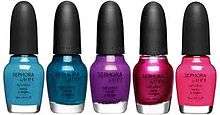
There are 15 principal nail polish finishes:[16][17]
- Shimmer
- Micro-shimmer
- Micro-glitter
- Glitter
- Frost
- Lustre
- Creme
- Prismatic micro-glitter or shimmer
- Iridescent
- Opalescent
- Matte
- Duochrome[18]
- Jelly or translucent
- Magnetic
- Crackled
- Glass-flecked
- Holographic
Nail polish remover
Nail polish remover is an organic solvent that may also include oils, scents, and coloring. Nail polish remover packages may include individual felt pads soaked in remover, a bottle of liquid remover used with a cotton ball or cotton pad, or a container filled with foam into which one inserts a finger and twists it until the polish comes off. Choosing a type of remover is determined by the user's preference, and often the price or quality of the remover.
The most common remover is acetone. This can be harsh on skin and nails.[19] Acetone can also remove artificial nails made of acrylic or cured gel.
A less harsh nail polish remover is ethyl acetate, which often also contains isopropyl alcohol.[20] Ethyl acetate is usually the original solvent for nail polish itself.
Acetonitrile has been used as a nail polish remover, but it is more toxic and potentially more carcinogenic than the aforementioned options. It has been banned in the European Economic Area for use in cosmetics since 17 March 2000.[21]
Health concerns
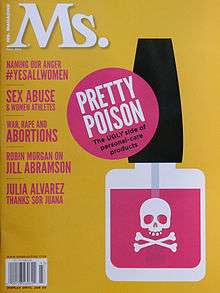
The health risks associated with nail polish are disputed. According to the U.S. Department of Health and Human Services, "The amount of chemicals used in animal studies is probably a couple of hundred times higher than what you would be exposed to from using nail polish every week or so. So the chances of any individual phthalate producing such harm [in humans] is very slim."[22] A more serious health risk is faced by professional nail technicians, who perform manicures over a workstation, known as a nail table, on which the client's hands rest – directly below the technician's breathing zone. In 2009, Susan Reutman, an epidemiologist with the U.S. National Institute for Occupational Safety and Health's Division of Applied Research and Technology, announced a federal effort to evaluate the effectiveness of downdraft vented nail tables (VNTs) in removing potential nail polish chemical and dust exposures from the technician's work area.[23] These ventilation systems have potential to reduce worker exposure to chemicals by at least 50%.[24] Many nail technicians will often wear masks to cover their mouth and nose from inhaling any of the harsh dust or chemicals from the nail products.
According to Reutman, a growing body of scientific literature suggests that some inhaled and absorbed organic solvents found in nail salons such as glycol ethers and carbon disulfide may have adverse effects on reproductive health. These effects may including birth defects, low birth weight, miscarriage, and preterm birth.[23]
Nail polish formulations may include ingredients that are toxic or affect other health problems. One controversial family of ingredient are phthalates,[10] which are implicated as endocrine disruptors and linked to problems in the endocrine system and increased risk of diabetes. Manufacturers have been pressured by consumer groups to reduce or to eliminate potentially-toxic ingredients,[25] and in September 2006, several companies agreed to phase out dibutyl phthalates.[26][27] There are no universal consumer safety standards for nail polish, however, and while formaldehyde has been eliminated from some nail polish brands, others still use it.[28]
Regulation and environmental concerns
The U.S. city of San Francisco enacted a city ordinance, publicly identifying establishments that use nail polishes free of the "toxic trio" of dibutyl phthalate, toluene, and formaldehyde.[29]
Nail polish is considered a hazardous waste by some regulatory bodies such as the Los Angeles Department of Public Works.[30] Many countries have strict restrictions on sending nail polish by mail.[31][32] The "toxic trio" are currently being phased out, but there are still components of nail polish that could cause environmental concern. Leaking out of the bottle into the soil could cause contamination in ground water.[33][34] Chromium(III) oxide green and Prussian blue are common in nail polish and have shown evidence of going through chemical degradation, which could have a detrimental effect on health.
References
- 1 2 3 4 5 Toedt, John; Koza, Darrell; Cleef-Toedt, Kathleen van (2005). Chemical Composition Of Everyday Products. Greenwood Publishing Group. p. 49. ISBN 978-0-313-32579-3.
- 1 2 Sherrow, Victoria (2001). For appearance' sake: The historical encyclopedia of good looks, beauty, and grooming. Phoenix: Oryx Press. p. 119. ISBN 978-1-57356-204-1.
- ↑ Draelos, Zoe Diana (2011). Cosmetic Dermatology: Products and Procedures. John Wiley & Sons. p. 46. ISBN 978-1-4443-5951-0.
- ↑ Alpert, Arlene; Altenburg, Margrit & Bailey, Diane (2002). Milady's Standard Cosmetology. Cengage Learning. p. 8. ISBN 978-1-56253-879-8.
- ↑ http://search.proquest.com/docview/1477854392
- 1 2 3 "On How to Be Lovely". Edwardian Promenade. 2010-04-15. Retrieved 2018-05-06.
- ↑ Günther Schneider, Sven Gohla, Jörg Schreiber, Waltraud Kaden, Uwe Schönrock, Hartmut Schmidt-Lewerkühne, Annegret Kuschel, Xenia Petsitis, Wolfgang Pape, water "Skin Cosmetics" in Ullmann's Encyclopedia of Industrial Chemistry 2005, Wiley-VCH, Weinheim. doi:10.1002/14356007.a24_219
- ↑ Toedt, John; Koza, Darrell; Cleef-Toedt, Kathleen van (2005). Chemical Composition Of Everyday Products. Greenwood Publishing Group. p. 50. ISBN 978-0-313-32579-3.
- ↑ Tosylamide/Formaldehyde Resin. cosmeticsinfo.org
- 1 2 Cunningham, J. (2013) "Color cosmetics" in Chemistry and Technology of the Cosmetics and Toiletries Industry. D. F. Williams and W. H. Schmitt (eds.). Springer. ISBN 978-94-010-7194-9
- ↑ Molina, Christina (31 March 2014). "How to Actually Remove Glitter Nail Polish for Good". Elle.com. Hearst Communications, Inc. Retrieved 2 April 2014.
- 1 2 "The One Step You Should NEVER Skip in Your Mani". Good Housekeeping. 2015-09-21. Retrieved 2018-05-06.
- ↑ Sun, Feifei (2013-01-28). "Nail Polish Sales Hit Record $768 Million in U.S." Time. Retrieved 2013-12-06.
- ↑ Romanowski, Shannon. "The Science Behind Magnetic Nail Polish". Self.com. Retrieved 22 June 2017.
- ↑ "Manly Manicures End in Color". The New York Times. 2013-06-12. Retrieved 2015-07-14.
- ↑ Mismas, Michelle. "Can you describe the different types of nail polish finishes?". AllLacqueredUp.com. All Lacquered Up. Retrieved 3 April 2014.
- ↑ "What is a jelly polish?". nouveaucheap.blogspot.com. Retrieved 1 September 2014.
- ↑ Emma Carlson Berne Nail Care Tips & Tricks 2015 - Page 13 1467786551 "Chrome. Many polishes give off a metallic sheen. Duochrome or multichrome polish contains several colors. The colors flash differently, depending on the reflection of the light. Iridescent polish is a softer version of duochrome."
- ↑ "Safety Data Sheet: Acetone" (PDF). JM Loveridge. Archived from the original (PDF) on 2013-11-01. Retrieved 2013-12-06.
- ↑ "Safer alternatives. Nail polish remover". Poison Control Center. Children's Hospital of Philadelphia. Retrieved 3 June 2013.
- ↑ Twenty-Fifth Commission Directive 2000/11/EC of 10 March 2000 adapting to technical progress Annex II to Council Directive 76/768/EEC on the approximation of laws of the Member States relating to cosmetic products. OJEC L65 of 14 March 2000, pp. 22–25.
- ↑ Bender, Michele (2004). "Nail polish gets a healthy makeover". Health. 18 (10): 34.
- 1 2 Reutman, Susan (3 March 2009). "Nail Salon Table Evaluation". National Institute for Occupational Safety and Health (NIOSH) Science Blog. Centers for Disease Control and Prevention. Retrieved 3 April 2014.
- ↑ Marlow, David A.; Looney, Timothy; Reutman, Susan (September 2012). "An Evaluation of Local Exhaust Ventilation Systems for Controlling Hazardous Exposures in Nail Salons (EPHB Report No. 005-164)" (PDF). Department of Health and Human Services, Centers for Disease Control and Prevention, National Institute for Occupational Safety and Health. Retrieved 5 March 2013.
- ↑ "Dangers of Nail Polish – Toxic Chemicals in your nail polish". TorquayHeraldExpress.co.uk. Local World, Ltd. 1 April 2014. Archived from the original on 5 April 2014. Retrieved 2 April 2014.
With inviting names such as peaches and cream or Caramel Smoothie, you are led away from the potential dangers of these polishes, with some ingredients that are known cancer causing chemicals and those toxic to the nervous system. The top three chemicals of concern are toluene, dibutyl phthalate (dbp) and formaldehyde – the so called 'toxic trio'.
- ↑ Singer, Natasha (7 September 2006). "Nail Polish Makers Yield on Disputed Chemical". The New York Times.
- ↑ Phthalate chemicals in nail polish, hair sprays tied to raised diabetes risk in women. CBS News (2012-07-16). Retrieved on 2015-11-22.
- ↑ Simon, Pitman (30 August 2006). "Nail Polish manufacturers remove potentially harmful chemicals". Cosmetic Design USA. William Reed Business Media.
- ↑ Brown, Patricia Leigh (10 November 2010). "At Some Nail Salons, Feeling Pretty and Green". The New York Times.
- ↑ "What is Household Hazardous Waste (HHW)?". County of Los Angeles Department of Public Works. Retrieved 7 August 2013.
- ↑ "Restricted goods – personal customers: Things we can carry in UK post but with restrictions". Royal Mail. Retrieved 2013-12-06.
- ↑ "Restricted and Hazardous Materials". US Postal Service. Retrieved 2013-12-06.
- ↑ "STOP: Why You Shouldn't Throw Old Nail Polish In The Trash". 2016-07-31. Retrieved 2018-05-06.
- ↑ "Nail Care Products". fda.gov. Food and Drug Administration.
Further reading
- Charles Panati, Extraordinary Origins of Everyday Things, Harper & Row, 1987
External links
| Wikimedia Commons has media related to Nail polish. |